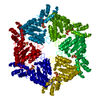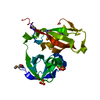[English] 日本語
 Yorodumi
Yorodumi- PDB-3j96: Structure of 20S supercomplex determined by single particle cryoe... -
+ Open data
Open data
- Basic information
Basic information
| Entry | Database: PDB / ID: 3j96 | ||||||
|---|---|---|---|---|---|---|---|
| Title | Structure of 20S supercomplex determined by single particle cryoelectron microscopy (State I) | ||||||
 Components Components |
| ||||||
 Keywords Keywords | HYDROLASE / vesicle trafficking | ||||||
| Function / homology |  Function and homology information Function and homology informationexocytic insertion of neurotransmitter receptor to postsynaptic membrane / trans-Golgi Network Vesicle Budding / regulation of delayed rectifier potassium channel activity / Intra-Golgi traffic / Retrograde transport at the Trans-Golgi-Network / COPI-dependent Golgi-to-ER retrograde traffic / COPI-mediated anterograde transport / soluble NSF attachment protein activity / BLOC-1 complex / myosin head/neck binding ...exocytic insertion of neurotransmitter receptor to postsynaptic membrane / trans-Golgi Network Vesicle Budding / regulation of delayed rectifier potassium channel activity / Intra-Golgi traffic / Retrograde transport at the Trans-Golgi-Network / COPI-dependent Golgi-to-ER retrograde traffic / COPI-mediated anterograde transport / soluble NSF attachment protein activity / BLOC-1 complex / myosin head/neck binding / Lysosome Vesicle Biogenesis / zymogen granule membrane / storage vacuole / synaptic vesicle fusion to presynaptic active zone membrane / Other interleukin signaling / synaptobrevin 2-SNAP-25-syntaxin-1a-complexin II complex / synaptobrevin 2-SNAP-25-syntaxin-1a complex / presynaptic dense core vesicle exocytosis / synaptobrevin 2-SNAP-25-syntaxin-1a-complexin I complex / extrinsic component of presynaptic membrane / calcium ion-regulated exocytosis of neurotransmitter / Glutamate Neurotransmitter Release Cycle / Norepinephrine Neurotransmitter Release Cycle / Acetylcholine Neurotransmitter Release Cycle / Serotonin Neurotransmitter Release Cycle / COPII-mediated vesicle transport / GABA synthesis, release, reuptake and degradation / positive regulation of norepinephrine secretion / positive regulation of catecholamine secretion / Dopamine Neurotransmitter Release Cycle / synaptic vesicle docking / eosinophil degranulation / SNARE complex disassembly / Golgi Associated Vesicle Biogenesis / regulation of synaptic vesicle priming / regulated exocytosis / Insertion of tail-anchored proteins into the endoplasmic reticulum membrane / vesicle-mediated transport in synapse / protein-containing complex disassembly / regulation of establishment of protein localization / positive regulation of calcium ion-dependent exocytosis / positive regulation of intracellular protein transport / ribbon synapse / vesicle docking / regulation of vesicle-mediated transport / regulation of exocytosis / Cargo recognition for clathrin-mediated endocytosis / chloride channel inhibitor activity / secretion by cell / Clathrin-mediated endocytosis / SNARE complex / SNAP receptor activity / calcium-ion regulated exocytosis / vesicle fusion / ATP-dependent protein disaggregase activity / actomyosin / hormone secretion / LGI-ADAM interactions / positive regulation of ATP-dependent activity / positive regulation of hormone secretion / intra-Golgi vesicle-mediated transport / neuron projection terminus / Golgi to plasma membrane protein transport / ATP-dependent protein binding / Golgi stack / neurotransmitter secretion / protein localization to membrane / apical protein localization / clathrin-coated vesicle / syntaxin binding / vesicle-fusing ATPase / syntaxin-1 binding / regulation of synaptic vesicle recycling / insulin secretion / endosomal transport / Neutrophil degranulation / SNARE complex assembly / positive regulation of neurotransmitter secretion / regulation of synapse assembly / neurotransmitter transport / myosin binding / response to gravity / regulation of neuron projection development / synaptic vesicle priming / exocytosis / positive regulation of receptor recycling / modulation of excitatory postsynaptic potential / associative learning / protein sumoylation / positive regulation of exocytosis / synaptic vesicle exocytosis / voltage-gated potassium channel activity / synaptic vesicle endocytosis / positive regulation of excitatory postsynaptic potential / long-term memory / postsynaptic cytosol / response to glucose / axonal growth cone / calcium channel inhibitor activity / vesicle-mediated transport Similarity search - Function | ||||||
| Biological species |   | ||||||
| Method | ELECTRON MICROSCOPY / single particle reconstruction / cryo EM / Resolution: 7.6 Å | ||||||
 Authors Authors | Zhao, M. / Wu, S. / Cheng, Y. / Brunger, A.T. | ||||||
 Citation Citation |  Journal: Nature / Year: 2015 Journal: Nature / Year: 2015Title: Mechanistic insights into the recycling machine of the SNARE complex. Authors: Minglei Zhao / Shenping Wu / Qiangjun Zhou / Sandro Vivona / Daniel J Cipriano / Yifan Cheng / Axel T Brunger /  Abstract: Evolutionarily conserved SNARE (soluble N-ethylmaleimide sensitive factor attachment protein receptors) proteins form a complex that drives membrane fusion in eukaryotes. The ATPase NSF (N- ...Evolutionarily conserved SNARE (soluble N-ethylmaleimide sensitive factor attachment protein receptors) proteins form a complex that drives membrane fusion in eukaryotes. The ATPase NSF (N-ethylmaleimide sensitive factor), together with SNAPs (soluble NSF attachment protein), disassembles the SNARE complex into its protein components, making individual SNAREs available for subsequent rounds of fusion. Here we report structures of ATP- and ADP-bound NSF, and the NSF/SNAP/SNARE (20S) supercomplex determined by single-particle electron cryomicroscopy at near-atomic to sub-nanometre resolution without imposing symmetry. Large, potentially force-generating, conformational differences exist between ATP- and ADP-bound NSF. The 20S supercomplex exhibits broken symmetry, transitioning from six-fold symmetry of the NSF ATPase domains to pseudo four-fold symmetry of the SNARE complex. SNAPs interact with the SNARE complex with an opposite structural twist, suggesting an unwinding mechanism. The interfaces between NSF, SNAPs, and SNAREs exhibit characteristic electrostatic patterns, suggesting how one NSF/SNAP species can act on many different SNARE complexes. | ||||||
| History |
|
- Structure visualization
Structure visualization
| Movie |
 Movie viewer Movie viewer |
|---|---|
| Structure viewer | Molecule:  Molmil Molmil Jmol/JSmol Jmol/JSmol |
- Downloads & links
Downloads & links
- Download
Download
| PDBx/mmCIF format |  3j96.cif.gz 3j96.cif.gz | 896 KB | Display |  PDBx/mmCIF format PDBx/mmCIF format |
|---|---|---|---|---|
| PDB format |  pdb3j96.ent.gz pdb3j96.ent.gz | 724.4 KB | Display |  PDB format PDB format |
| PDBx/mmJSON format |  3j96.json.gz 3j96.json.gz | Tree view |  PDBx/mmJSON format PDBx/mmJSON format | |
| Others |  Other downloads Other downloads |
-Validation report
| Summary document |  3j96_validation.pdf.gz 3j96_validation.pdf.gz | 1 MB | Display |  wwPDB validaton report wwPDB validaton report |
|---|---|---|---|---|
| Full document |  3j96_full_validation.pdf.gz 3j96_full_validation.pdf.gz | 1.2 MB | Display | |
| Data in XML |  3j96_validation.xml.gz 3j96_validation.xml.gz | 159.6 KB | Display | |
| Data in CIF |  3j96_validation.cif.gz 3j96_validation.cif.gz | 239.6 KB | Display | |
| Arichive directory |  https://data.pdbj.org/pub/pdb/validation_reports/j9/3j96 https://data.pdbj.org/pub/pdb/validation_reports/j9/3j96 ftp://data.pdbj.org/pub/pdb/validation_reports/j9/3j96 ftp://data.pdbj.org/pub/pdb/validation_reports/j9/3j96 | HTTPS FTP |
-Related structure data
| Related structure data |  6206MC  6204C  6205C  6207C  6208C  6209C  6210C  3j94C  3j95C  3j97C  3j98C  3j99C M: map data used to model this data C: citing same article ( |
|---|---|
| Similar structure data |
- Links
Links
- Assembly
Assembly
| Deposited unit | 
|
|---|---|
| 1 |
|
- Components
Components
| #1: Protein | Mass: 82907.430 Da / Num. of mol.: 6 Source method: isolated from a genetically manipulated source Source: (gene. exp.)   #2: Protein | Mass: 33377.793 Da / Num. of mol.: 4 Source method: isolated from a genetically manipulated source Source: (gene. exp.)   #3: Protein | | Mass: 7231.061 Da / Num. of mol.: 1 / Fragment: UNP residues 28-89 Source method: isolated from a genetically manipulated source Source: (gene. exp.)   #4: Protein | | Mass: 7837.957 Da / Num. of mol.: 1 / Fragment: UNP residues 191-256 Source method: isolated from a genetically manipulated source Source: (gene. exp.)   #5: Protein | | Mass: 21256.855 Da / Num. of mol.: 1 Source method: isolated from a genetically manipulated source Source: (gene. exp.)   |
|---|
-Experimental details
-Experiment
| Experiment | Method: ELECTRON MICROSCOPY |
|---|---|
| EM experiment | Aggregation state: PARTICLE / 3D reconstruction method: single particle reconstruction |
- Sample preparation
Sample preparation
| Component |
| |||||||||||||||||||||||||||||||||||
|---|---|---|---|---|---|---|---|---|---|---|---|---|---|---|---|---|---|---|---|---|---|---|---|---|---|---|---|---|---|---|---|---|---|---|---|---|
| Molecular weight | Value: 0.66 MDa / Experimental value: NO | |||||||||||||||||||||||||||||||||||
| Buffer solution | Name: 50 mM Tris-Cl, 150 mM NaCl, 1 mM AMPPNP, 1 mM EDTA, 1 mM DTT, 0.05% v/v Nonident P-40 pH: 8 Details: 50 mM Tris-Cl, 150 mM NaCl, 1 mM AMPPNP, 1 mM EDTA, 1 mM DTT, 0.05% v/v Nonident P-40 | |||||||||||||||||||||||||||||||||||
| Specimen | Conc.: 15 mg/ml / Embedding applied: NO / Shadowing applied: NO / Staining applied: NO / Vitrification applied: YES | |||||||||||||||||||||||||||||||||||
| Specimen support | Details: Holey carbon on top of 400 mesh copper grid | |||||||||||||||||||||||||||||||||||
| Vitrification | Instrument: FEI VITROBOT MARK I / Cryogen name: ETHANE / Temp: 90 K / Humidity: 100 % Details: Blot for 3.5 seconds before plunging into liquid ethane (FEI VITROBOT MARK I). Method: Blot for 3.5 seconds before plunging |
- Electron microscopy imaging
Electron microscopy imaging
| Experimental equipment |  Model: Tecnai Polara / Image courtesy: FEI Company |
|---|---|
| Microscopy | Model: FEI POLARA 300 / Date: Jan 28, 2014 |
| Electron gun | Electron source:  FIELD EMISSION GUN / Accelerating voltage: 300 kV / Illumination mode: FLOOD BEAM FIELD EMISSION GUN / Accelerating voltage: 300 kV / Illumination mode: FLOOD BEAM |
| Electron lens | Mode: BRIGHT FIELD / Nominal magnification: 31000 X / Nominal defocus max: -2800 nm / Nominal defocus min: -1800 nm / Cs: 2.3 mm / Camera length: 0 mm |
| Specimen holder | Specimen holder model: OTHER / Specimen holder type: unspecified |
| Image recording | Electron dose: 44 e/Å2 / Film or detector model: GATAN K2 (4k x 4k) |
| Radiation | Protocol: SINGLE WAVELENGTH / Monochromatic (M) / Laue (L): M / Scattering type: x-ray |
| Radiation wavelength | Relative weight: 1 |
- Processing
Processing
| EM software |
| |||||||||||||||||||||||||||||||||||||||||||||||||||||||||||||||||||||||||||||||||||||||||||||||||||||||||||||||||||||||||||||||||||||||||||||||||||||||||||||||||||||||||||||||||||||||||||||||||||||||||||||||||||||||||
|---|---|---|---|---|---|---|---|---|---|---|---|---|---|---|---|---|---|---|---|---|---|---|---|---|---|---|---|---|---|---|---|---|---|---|---|---|---|---|---|---|---|---|---|---|---|---|---|---|---|---|---|---|---|---|---|---|---|---|---|---|---|---|---|---|---|---|---|---|---|---|---|---|---|---|---|---|---|---|---|---|---|---|---|---|---|---|---|---|---|---|---|---|---|---|---|---|---|---|---|---|---|---|---|---|---|---|---|---|---|---|---|---|---|---|---|---|---|---|---|---|---|---|---|---|---|---|---|---|---|---|---|---|---|---|---|---|---|---|---|---|---|---|---|---|---|---|---|---|---|---|---|---|---|---|---|---|---|---|---|---|---|---|---|---|---|---|---|---|---|---|---|---|---|---|---|---|---|---|---|---|---|---|---|---|---|---|---|---|---|---|---|---|---|---|---|---|---|---|---|---|---|---|---|---|---|---|---|---|---|---|---|---|---|---|---|---|---|---|
| CTF correction | Details: Each particle | |||||||||||||||||||||||||||||||||||||||||||||||||||||||||||||||||||||||||||||||||||||||||||||||||||||||||||||||||||||||||||||||||||||||||||||||||||||||||||||||||||||||||||||||||||||||||||||||||||||||||||||||||||||||||
| Symmetry | Point symmetry: C1 (asymmetric) | |||||||||||||||||||||||||||||||||||||||||||||||||||||||||||||||||||||||||||||||||||||||||||||||||||||||||||||||||||||||||||||||||||||||||||||||||||||||||||||||||||||||||||||||||||||||||||||||||||||||||||||||||||||||||
| 3D reconstruction | Resolution: 7.6 Å / Resolution method: FSC 0.143 CUT-OFF / Num. of particles: 29717 / Nominal pixel size: 2.4312 Å / Actual pixel size: 2.4312 Å Details: (Single particle details: 3D classification, refinement, and reconstruction were performed using RELION) (Single particle--Applied symmetry: C1) Symmetry type: POINT | |||||||||||||||||||||||||||||||||||||||||||||||||||||||||||||||||||||||||||||||||||||||||||||||||||||||||||||||||||||||||||||||||||||||||||||||||||||||||||||||||||||||||||||||||||||||||||||||||||||||||||||||||||||||||
| Atomic model building | Protocol: FLEXIBLE FIT / Space: RECIPROCAL / Target criteria: R-factor Details: REFINEMENT PROTOCOL--flexible DETAILS--D2 domain of NSF was from crystal structure 1NSF. D1 domain of NSF was from related entry EMD-6204. N domain of NSF was from crystal structure 1QCS. ...Details: REFINEMENT PROTOCOL--flexible DETAILS--D2 domain of NSF was from crystal structure 1NSF. D1 domain of NSF was from related entry EMD-6204. N domain of NSF was from crystal structure 1QCS. aSNAP was a homology model. SNARE complex was from crystal structure 1N7S. | |||||||||||||||||||||||||||||||||||||||||||||||||||||||||||||||||||||||||||||||||||||||||||||||||||||||||||||||||||||||||||||||||||||||||||||||||||||||||||||||||||||||||||||||||||||||||||||||||||||||||||||||||||||||||
| Atomic model building | 3D fitting-ID: 1 / Source name: PDB / Type: experimental model
| |||||||||||||||||||||||||||||||||||||||||||||||||||||||||||||||||||||||||||||||||||||||||||||||||||||||||||||||||||||||||||||||||||||||||||||||||||||||||||||||||||||||||||||||||||||||||||||||||||||||||||||||||||||||||
| Refinement | Resolution: 7.6→7.6 Å / SU ML: 1.53 / σ(F): 0.5 / Phase error: 40.44 / Stereochemistry target values: ML
| |||||||||||||||||||||||||||||||||||||||||||||||||||||||||||||||||||||||||||||||||||||||||||||||||||||||||||||||||||||||||||||||||||||||||||||||||||||||||||||||||||||||||||||||||||||||||||||||||||||||||||||||||||||||||
| Solvent computation | Shrinkage radii: 0.9 Å / VDW probe radii: 1.11 Å / Solvent model: FLAT BULK SOLVENT MODEL | |||||||||||||||||||||||||||||||||||||||||||||||||||||||||||||||||||||||||||||||||||||||||||||||||||||||||||||||||||||||||||||||||||||||||||||||||||||||||||||||||||||||||||||||||||||||||||||||||||||||||||||||||||||||||
| Displacement parameters | Biso max: 550 Å2 / Biso mean: 500.074 Å2 / Biso min: 30 Å2 | |||||||||||||||||||||||||||||||||||||||||||||||||||||||||||||||||||||||||||||||||||||||||||||||||||||||||||||||||||||||||||||||||||||||||||||||||||||||||||||||||||||||||||||||||||||||||||||||||||||||||||||||||||||||||
| Refinement step | Cycle: LAST / Resolution: 7.601→311.194 Å
| |||||||||||||||||||||||||||||||||||||||||||||||||||||||||||||||||||||||||||||||||||||||||||||||||||||||||||||||||||||||||||||||||||||||||||||||||||||||||||||||||||||||||||||||||||||||||||||||||||||||||||||||||||||||||
| Refine LS restraints |
| |||||||||||||||||||||||||||||||||||||||||||||||||||||||||||||||||||||||||||||||||||||||||||||||||||||||||||||||||||||||||||||||||||||||||||||||||||||||||||||||||||||||||||||||||||||||||||||||||||||||||||||||||||||||||
| LS refinement shell | Refine-ID: ELECTRON MICROSCOPY / Total num. of bins used: 30
|
 Movie
Movie Controller
Controller



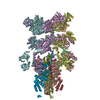
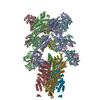
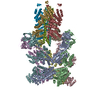

 PDBj
PDBj









